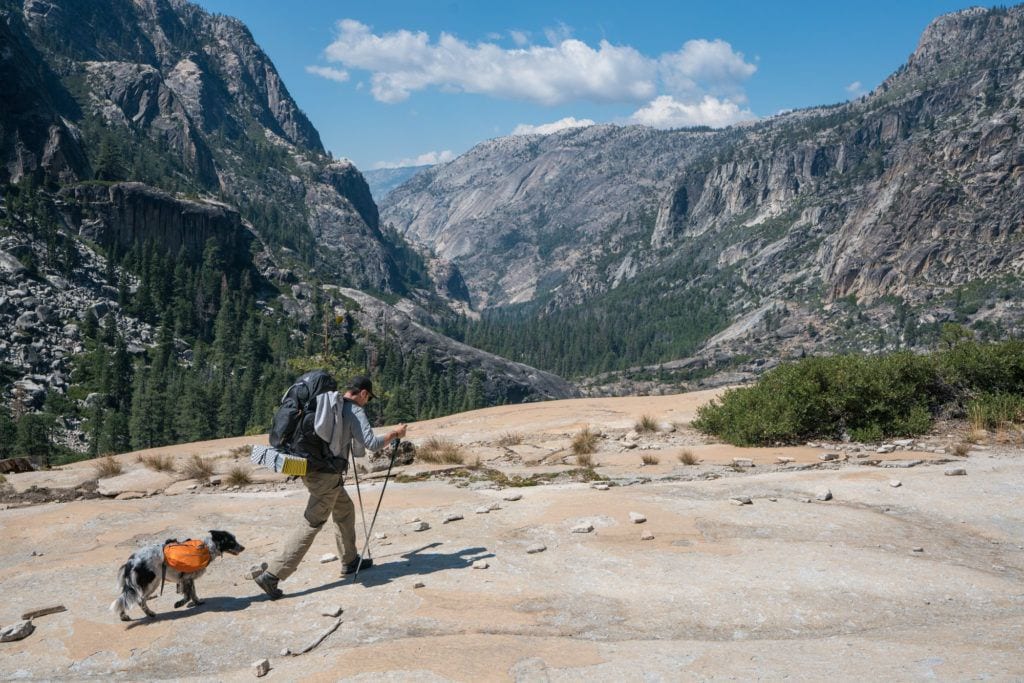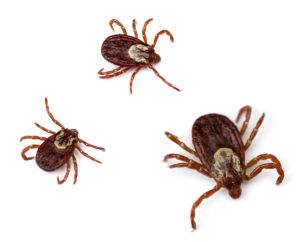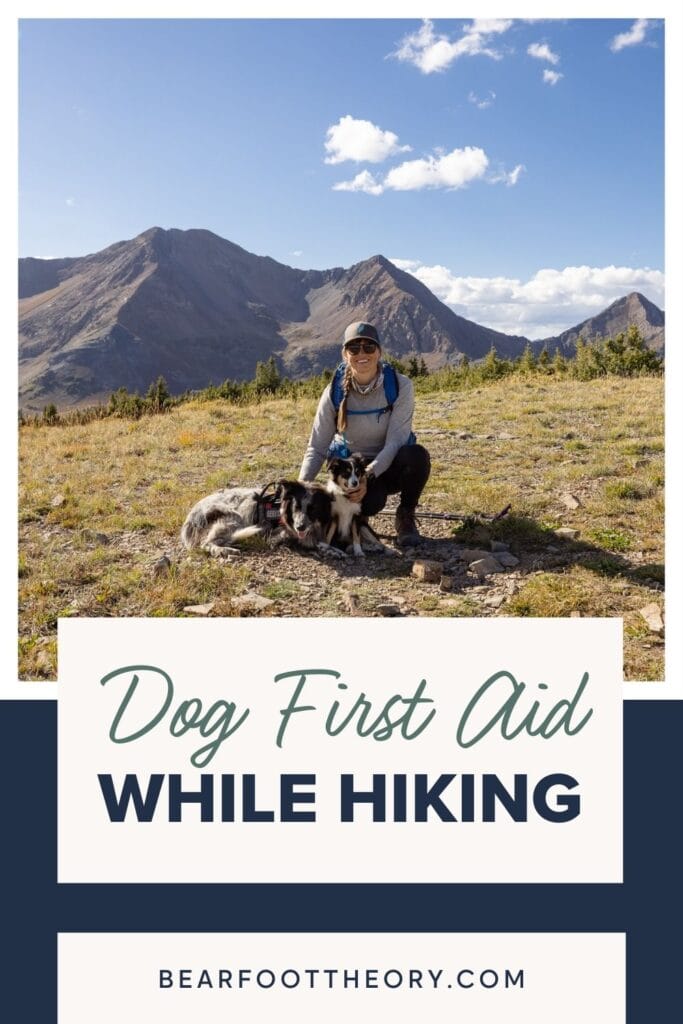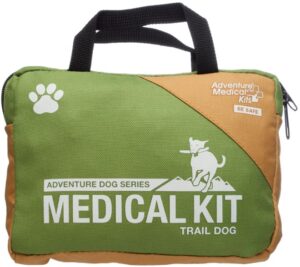Products You May Like
It’s important to keep your dog’s safety top of mind when you’re preparing to go hiking, backpacking, or on other outdoor adventures. What if something goes wrong unexpectedly when you’re miles from help? Is your personal first aid kit equipped to handle canine-specific medical needs? While there is some overlap with human care, dog first aid for hiking differs from us since they have unique anatomy that requires different care (for example, their footpads).
For anyone heading into the woods with their favorite canine companion, read on for advice from Dr. Nancy East about common risks dogs face in the woods, what signs to look for with various situations, and how to help them (without needing a veterinary degree) until you can get them back into civilization and to your veterinarian. Making a dog first aid kit for hiking requires very few items and can easily be done using a small Ziploc bag that you keep in your hiking bag alongside your own first aid essentials.
Learn how to treat common pet injuries in the backcountry and how to make your own dog first aid kit for hiking to keep your pooch safe on every adventure.
Disclaimer: The information in this post is not meant to replace the advice of your veterinarian. Consult your veterinarian before administering over-the-counter medications to your pet.
Insect Stings
Just like people, dogs hate to be stung by bees! They have a nice coat that protects them to some degree, but it’s not going to protect them completely. In over 20 years of practicing small animal medicine, I’ve never seen a dog have an anaphylactic reaction from an insect sting, and they are very rare. That being said, in theory, any foreign substance a dog is exposed to can cause an anaphylactic reaction, just as in people. By definition, anaphylaxis involves two organ systems. So in addition to a local skin reaction, if your dog is having difficulty breathing or starts to vomit or have diarrhea shortly after being stung, it’s time to high tail it out of the woods and get them to a veterinarian.
Symptoms of Insect Stings on Dogs
- Discomfort at the sting site
- Redness or hives in the area where they were stung
- Swelling at the site or sometimes in the face/muzzle area, even if they weren’t stung there.
- Itchiness at the site where they were stung (this usually comes later, not immediately following a sting)
Treatment of Insect Stings on Dogs
- If it’s still there, remove the stinger with tweezers.
- Over-the-counter Benadryl (diphenhydramine is the generic form of Benadryl and works just as well) given at a dose of 1 mg per pound of body weight (so if your dog weighs 50 pounds, you’d give 50 mg). The good news is you probably already carry Benadryl in your own first aid kit, if not, make sure to put some in your dog first aid kit for hiking.
Dog Sprains & Strains
Dogs typically have amazing agility on trails and can navigate terrain more gracefully than we do, but they are certainly not immune to sprains and strains occasionally. The good news is that, unlike a human, they have three extra legs (assuming only one leg is injured), so they can often hobble out without too much fuss; however, it’s nice to know how you can help them along the way and what to look for if you’re worried.
Symptoms of Dog Sprains/Strains
- Swelling at the site
- Discomfort to palpation (that’s just a fancy word for “touching”)
- Limping or carrying the leg off the ground completely
- Deformity of the limb is rare–if something looks odd besides some swelling, there’s a chance the limb has a broken bone or damaged ligaments and/or tendons.
- Before you assume the injury is a sprain/strain, make sure to check the food pads for injury or foreign bodies, such as grass awns, becoming stuck in the pad or the hair in between them.
Treatment of Sprains/Strains
- If you hike often with your dog, ask your veterinarian if he/she thinks that a small supply of a non-steroidal anti-inflammatory drug (NSAID) is something you could have on hand in your dog first aid kit for hiking. These are commonly used drugs for anything from osteoarthritis to post-surgical pain relief to minor injuries and are very safe for short-term use in most dogs.
- Aspirin is not the best choice of an NSAID for a dog, so I don’t recommend it.
- Typically, when I see a patient with a sprain or strain, I recommend exercise restriction. Obviously, this doesn’t work so well in the backcountry. That being said, if your dog starts limping during a hike, save the big miles for another day and head on home.

Foot Pad Injuries
Since dogs essentially hike “barefoot” it leaves their footpads open to injury on the trail. The most common injury to footpads is abrasions and bruising, but they are also susceptible to foreign bodies such as grass awns becoming entrapped in the fur between their pads or puncturing a footpad, and lacerations.
Treatment options depend on the type of injury but make sure to check the paw thoroughly for foreign bodies that may be hiding and causing the issue. The treatment may be as simple as removing a foreign substance that’s irritating and painful to walk on. If there is an actual wound, flushing it with clean water and keeping it clean and dry with bandaging material such as gauze pads and vet tape wrap is often helpful.
Prevention is also an important step with food pads, and hiking booties may help stave off issues while hiking in rough terrain. Also, dogs who walk regularly are less prone to footpad injuries, since their pads are already “toughened up” to some degree. You can always stuff booties in your dog’s first aid kit for hiking as a backup just in case the trail is rougher than you anticipated it to be.
Snake Bites
For starters, research what venomous snakes you might encounter wherever you’re hiking with your dog. If your dog is bitten by a snake, it will help if you can recognize the snake as venomous or not. If at all possible without putting yourself in harm’s way, take a photo of the snake to show your veterinarian, as this will help him/her know how to treat your dog in the most effective way.
The most common place dogs are bitten, at least in my experience, is on the muzzle. Curious noses often get themselves into unintended trouble! The lower legs are the second most common place I’ve observed.
Symptoms of Snake Bites
- Swelling at the site of the bite
- Small puncture wounds at the site of the bite (usually two but sometimes more or less than that)
- Bleeding (not always, but depending on the type of snake that bites your dog, they may actively bleed from the site)
- Pain at the site of the bite
Treatment of Snake Bites
- Just like insect stings, Benadryl (diphenhydramine) is beneficial with snake bites. The same dose of 1 mg per pound of body weight applies.
- Veterinarian-prescribed NSAIDs as mentioned above in the sprains/strains section.
- DO NOT try to enlarge the bite site, apply a tourniquet if a leg was bitten, and/or try to suck out the venom. From my experience, snake bite kits are a good way to waste your money in general, and they are highly ineffective in both people and dogs.
- The biggest takeaway, especially if you’re certain your dog has been bitten by a venomous snake, is to head out of the woods immediately and keep your dog as calm as possible. If they are a small breed that you can carry out, even better, as it will keep their heart rate down which is beneficial to prevent toxin circulation. Even non-venomous bites need attention sooner vs. later too, as antibiotics are often prescribed to ward off any bacterial infection the bite may have inoculated your pet with from its mouth.
Heat Exhaustion/Stroke
Dogs have a naturally higher core body temperature than humans. Couple that with a year-round fur coat and an inability to sweat and wet their coat to cool it down, and you can easily see how heat exhaustion/stroke is a risk for dogs on trails. The key to avoiding heat-related illness is prevention. Here are a few pointers:
- Hike in cooler temperatures or early/late in the day.
- Take them to a groomer for a shorter cut in the summer months, if they have a thick or long coat.
- Keep them out of the direct sun as much as possible.
- Always pack water on hikes with your dog and allow them opportunities to take water and relaxation breaks. Don’t forget to pack a collapsible water bowl for your pup!
Also, certain breeds are more predisposed to heat-related issues, especially brachycephalic breeds (the kind with flattened faces, like Pugs, Pekinese, English Bulldogs, etc.). If you have one of these breeds, a short walk in the neighborhood might be a safer bet for them than a remote trail in the woods! You can also try this cooling vest made by Ruffwear which helps reduce their body temperature in the heat.
Symptoms of Heat Exhaustion/Stroke
- Excessive panting
- Excessive salivation
- Listlessness or reluctance to keep hiking
Heatstroke, a much more serious condition than heat exhaustion, typically involves muscle tremors, vomiting/diarrhea, stumbling/collapsing, loss of consciousness, and/or seizures. The key is to not let your dog get to this point by recognizing the signs of heat exhaustion first and addressing them accordingly.
Treatment of Heat Exhaustion/Stroke
- Stop hiking and find shade, if possible. If there is no natural shade and it’s sunny and warm outside, try to create shade over them with what you have in your pack or carry a small foldable shade blanket in your dog first aid kit for hiking.
- Cool your dog down with water but do not submerge him/her in cold water or use ice water if you suspect he/she is suffering from heat stroke. The key is to cool them down efficiently but not too quickly which can lead to more problems. This is more important with heat stroke, but it’s better to be safe than sorry!
- Focus on applying water near the abdomen and neck areas.
- Circulate air by fanning him/her after applying water to the body.
- Alcohol wipes can be applied to the foot pads.
- Cut the hike short and head on out. If your dog is small enough, carrying them out if ideal, especially if they’re still overheated.
Ticks
Of paramount importance, if you hike with your dog, I highly recommend you use a tick preventive, BEFORE heading out to the trail. There are many effective ones on the market that your veterinarian can recommend to you. However, if you find a tick attached to your dog, here’s what you need to know.
Symptoms of Ticks
- Most dogs will not exhibit any signs of tick-borne disease within the time frame you’ll be in the woods (unless you’re thru-hiking a long distance trail with them).
- Most dogs won’t give you any cues that they have a tick. Many species of ticks are difficult to see, especially in thick coated dogs.
- If you get home and your dog exhibits any of the following signs within a week or so of your hike, and you know a tick was attached at some point, get to them your veterinarian as they may have a tick-borne disease: lameness, swelling, lethargy, nose bleeds, head tilting or trouble walking.
- Rarely, certain species of female ticks will release a neurotoxin in their saliva and cause paralysis in dogs. The paralysis usually doesn’t happen until about a week after the tick attaches. So if you’ve been on a hike in the last week and your dog is showing steady signs of unsteadiness and weakness, make sure you take them to your vet and let them know about your hike, so they can screen your dog thoroughly for ticks. Fortunately, the prognosis for a full recovery is good as long as you remove the tick and provide supportive care.
Treatment of Ticks
The best thing you can do it remove them as soon as you find them and do a full-body screening for them on both your dog (and yourself!) when you finish your hike. Removing them doesn’t require a lot of fanfare with a tick removal device or anything fancy. A pair of tweezers should work just fine or even using your fingers, which can be protected with a bandana or something in your pack. Just make sure you grab the tick near its head, as you want to make sure you remove that part.

Marijuana Inxtoxication
During a trip to Colorado this summer, Kristen’s dogs Charlie and Gumbo returned from a hike and things just seemed really “off”. Charlie was stumbling around, eyes rolling back in his head, trying to puke until he collapsed and was unable to stand up while Gumbo was anxiously bobbing her head back and forth — needless to say, this was a terrifying experience for a pet owner who had no idea what happened. After taking them to the vet, they immediately identified the culprit: THC (marijuana) intoxication from eating human poop.
When humans consume marijuana edibles (like cookies or gummies), the THC gets passed to their poop and that can cause marijuana intoxication in animals/wildlife if they eat the poop. This is becoming a big problem, especially in states with legal marijuana industries, where people are not pooping outside following proper Leave No Trace guidelines. Be sure to watch your dogs closely on the trail (as much as you can), and just be aware of the signs and symptoms to look out for:
Symptoms of Marijuana Intoxication in Dogs
- Wobbly and uncoordinated – unable to walk straight
- Hyperactive, disoriented, or very vocal
- Pupils may dialate and become wide-eyed
- Excessive drool or vomit
- Tremors or seizures (in severe cases)
Unfortunately, for most cases of marijuana intoxication in dogs, there is no treatment other than to keep an eye out, make them as comfortable as possible, and wait for the high to wear off. Although it is rarely deadly in animals, it is still extremely scary to watch your dog go through this. If you think your dog may have THC intoxication, call your veterinarian for the best course of action and to see if they need to be taken in.

What To Pack in Your Dog First Aid Kit for Hiking
If you’d like to do a DIY dog first aid kit for hiking, here are the essentials I recommend packing:
Another great option is to buy a premade Dog First Aid Kit, that comes with all the necessary supplies that you can easily toss in your hiking daypack.
If you have any questions or want to share your personal experience with dog first aid for hiking, please leave us a comment below! And be sure to check out Nancy’s blog, where you can download a free printable Canine First Aid “cheat sheet” to keep in your backpack.


